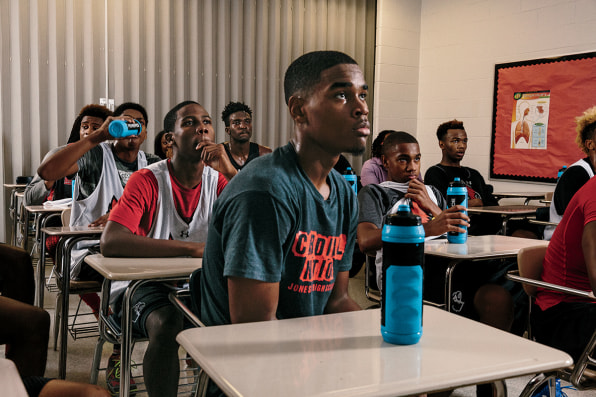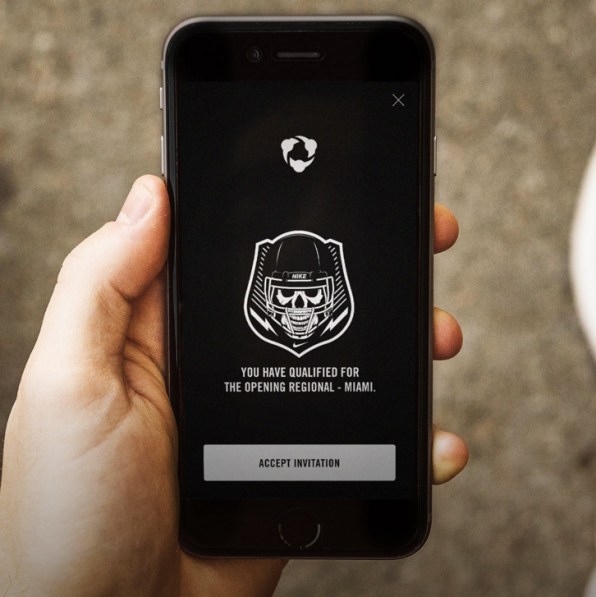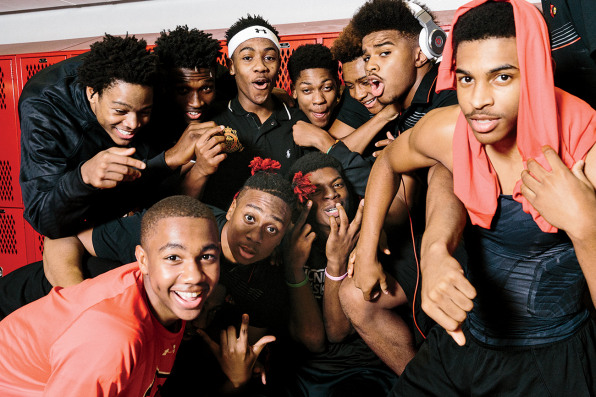Upload Stats to Hudl Using Web Services
An hour before dawn on a recent winter morning, the members of the Jonesboro High School basketball team file into a darkened classroom to sentinel tape from the previous night's win over Eagle'due south Landing. On newspaper, at to the lowest degree, the showing was impressive—the kind of come-from-behind, xiv-bespeak victory that catapulted Jonesboro, a public school in the outskirts of Atlanta, to back-to-dorsum Georgia state titles in 2014 and 2015.
But the Jonesboro Cardinals' motorcoach, Dan Maehlman, is having problem finding much to praise. "Exercise you know what information technology ways when I say deny? Am I speaking a foreign linguistic communication?" he asks, gripping his head every bit if information technology's about to crater open. He gestures at the projector screen, where 2 defenders are failing to intercept a lob pass. Maehlman rewinds and replays the offending sequence. "Let me endeavour this once more for you guys: Deny means that your goddamn player does not catch the goddamn basketball."
The players are largely silent. About accept already spent hours watching the record on their ain, on their smartphones, tablets, and home computers, using software called Hudl. At the meeting, Maehlman, besides, is using the engineering science. Created past three buddies from the Academy of Nebraska business concern schoolhouse, Hudl is built around digital video playback: Teams upload game films (captured either on a mobile device running the Hudl app or a digital camera) to Hudl servers, where they are instantly available to anyone with viewing permissions, from training staff to players to scouts and recruiters. Later, coaches can flag sections of the video (that unprompted turnover in the quaternary quarter or that specially balletic 2d-quarter steal), inserting notes, scribbles, or audio commentary for their players. They can also use those clips to create digital playbooks for the team. Athletes tap the software to study plays, edit and share highlight reels on their customizable Hudl profile pages, and send their coaches clips to clarify.

Or they tin can review and discuss in person, every bit Maehlman and the Jonesboro squad are doing today. A 6-foot-vi quondam forward for West Virginia'southward Alderson Broaddus Academy, the motorbus bears a close resemblance to an Appalachian acme—wide at the midsection, broader at the shoulders, and unforested at the summit. In Georgia high school basketball game circles, he has a reputation as a brilliant strategist (he was coach of the year in 2015) and a kind of anti-cheerleader: Even when his teams are winning by many points, he tends to stride the sidelines with a look that alternates between anguish and fury.
On the morning I sit in on the Cardinals' game review, Maehlman's ire is trained on his team's defense. He slides his hand over the track pad on his laptop, stopping the Hudl video at minute marker 21:23. The Cardinals' defence force is clustered around their ain net. "We were doing this all night long," Maehlman says. On the projector, the Cardinals jerk back to life. "We get the rebound, fine, merely then we decide, for some reason, that nosotros're going to dribble. Why?" Fast-forward. Stop. "At present here, nosotros have the rebound once more, and we make the outlet pass, simply it'south slow. It'due south sideways. Information technology's almost backwards, for God'southward sake."
At 8 a.thou., with a half hour before the first bell of the school day, the team heads to the gym and straight into an outlet drill. Continuing at half-court, Maehlman observes his sophomore eye, Jamari Mosley, distill off the rebound. "Jamari, did you see the aforementioned video as me?" he shouts. "Were yous listening? The adjacent role player that does that and the unabridged goddamn team is going to be running current of air sprints until viii:30 a.m." On the second go-circular, Mosley barely lets the ball hit the ground: jumping rebound, looping pass to his teammate, swish. "Okay," Maehlman says, mostly to himself. "Better." He sounds halfway convinced.
If a whiteboard and erasable marker were the primary tools of the trade for previous generations of coaches, Hudl is fast condign the 21st-century analogue. More than 100,000 sports outfits around the world currently rely on the software, paying annual subscription fees from $99 (for society teams) to as much as $50,000 (for pros)—and more for the boosted tools Hudl is starting to ringlet out. The service has been adopted by NFL teams and NHL squads and all but ane of the 30 NBA teams. Some of the world's most aristocracy international organizations, including FC Barcelona, the New Zealand All Blacks national rugby team, and almost all the English language Premier League clubs, have subscriptions. Hudl'south widest adoption, though, has been among college, loftier schoolhouse, and guild teams in the United States. In the basketball vertical lone, nearly 22,000 schools and colleges count Hudl every bit a foundational coaching tool.
Despite Hudl's ubiquity, many observers were taken past surprise when the bootstrapped, Lincoln, Nebraska–based startup announced last jump that it had raised $72.5 million in a single Series B investment round, giving it a $250 million valuation. Information technology was startling news to anyone unaware of the subtle nonetheless transformative effect Hudl has had on the style coaches and players at all levels communicate with one another and the exterior world.
"We want to capture and add value to every moment in sports," says CEO David Graff, who founded Hudl in 2006 with fellow computer engineers John Wirtz and Brian Kaiser. At Jonesboro High Schoolhouse, Hudl is integral to almost everything the basketball team does. The forenoon afterward most every game, Maehlman takes his players through his annotated reel; before big matchups, he screens films of the opposing team. In addition to the video features, the software keeps track of individual and squad stats and automatically creates graphs and colorful shot charts depicting patterns in the team'due south play.

Maehlman also uses Hudl when talking to recruiters. Last year, for instance, he directed representatives from a handful of colleges to the Hudl profile pages of two of his top players, Tariq Jenkins, a senior point baby-sit, and James "MJ" Walker Jr., a half dozen-foot-6 inferior shooting guard who'due south most certainly spring for the NBA. The profiles included highlight clips, stats, and fifty-fifty test scores and grade-betoken averages. "By the fourth dimension they got washed looking at those pages, the recruiters knew everything they needed to know," says Maehlman. "And I didn't have to spend hours emailing dorsum and along with them."
Like a lot of successful software, Hudl was conceived every bit a digital replacement for a task long done by hand—in this example, the substitution of the game tapes that coaches use to go on tabs on the competition. "Yous'd have people driving hundreds of miles to trade DVDs or waiting days for the things to come through the postal service," says Graff. "And once you got the record, there was so much data and and so many plays to break down and no like shooting fish in a barrel way to do information technology. We ready out to alter that."
In early 2006, Wirtz, Kaiser, and Graff, a graduate banana for the Nebraska athletic programme, managed to get a beta version of Hudl—then known every bit Huddle—in front of Beak Callahan, the head coach of the nationally ranked Cornhuskers football game squad. The software was pretty blank-bones: a media player, essentially. But Callahan immediately grasped the potential. If the pair could accept a finished version of the product ready by the beginning of the 2007 football season, Callahan said he would utilize it.
Luckily, Wirtz, Kaiser, and Graff had skillful timing: Video hardware was condign more affordable, equally was cloud storage. And the smartphone, while not nevertheless ubiquitous, was ascendant. Together with a small team of designers and user-interface experts, Wirtz, Kaiser, and Graff refined their software, edifice in the crucial ability to capture video via mobile devices and to review that tape on pocket-sized screens. When Callahan landed a job as banana coach of the New York Jets, he took Hudl with him.
The Hudl founders hoped other pro teams would quickly adopt their engineering, but that didn't happen. "We had viii months there where we were kind of beating our heads confronting the wall," Graff recalls. The quantum, every bit he tells it, was Hudl's decision to expand into high schoolhouse sports. After all, the pool of pro teams is small-scale. The high school market place is about limitless. And so in 2009, after opening a airplane pilot programme at 12 schools in Nebraska, Texas, and Kansas, Hudl dropped the starting toll of an annual subscription to $800 for high schools. By 2010, information technology had signed two,000 teams. The number grew from there: 7,000, 8,000, lxxx,000, more. And non only football game, simply likewise basketball game, soccer, baseball, and volleyball.
Hudl didn't just brand coaching easier; it changed the manner sports organizations operated. "Sports has been undergoing this tech revolution on then many levels, where information technology'due south all nigh having an objective arroyo to performance measurement," says Vince Gennaro, director of the sports direction program at Columbia University. "We now have wear technologies, loftier-speed cameras, Doppler radar, and data-collection devices that will measure everything from the pitch recognition of a batter in baseball game to the force of affect on a tackle in football to the spin rate and spin axis of a shot on goal in a soccer lucifer. And nosotros've only scratched the surface."
Hudl's genius was to democratize the tech revolution Gennaro describes by bringing it to pro teams equally well every bit high school, youth, and rec-league teams. Here were shareable, editable, accessible analytics of the kind typically reserved for moneyed pro organizations. "You'd have a conversation with one passenger vehicle, and adjacent thing y'all know, you'd get a phone call from some other a county over, someone proverb this is what he'due south been waiting for," recalls Jason Aldridge, a erstwhile football game coach and the Hudl sales rep for Georgia and South Carolina. "It was very much filling a void for these teams."

Every bit it grew, Hudl snapped up smaller competitors such equally DSV and Apex Sports, expanding its market share. Acquisitions of London-based Replay Analysis and Commonwealth of australia's Sportstec have helped grow Hudl's presence among international and elite teams. And with the purchase of startups like Ubersense, a slow-motion-video-analysis company, Hudl has expanded beyond its signature subscription app. The new Hudl Technique, a costless stand up-lonely app based on Ubersense lawmaking, lets athletes see the velocity and angles of, say, a golf swing or soccer kick, or the course of a free throw. The software, which has been used by Olympians in xx disciplines, gives Hudl entrée into non-team sports, such equally golf, lawn tennis, snowboarding, and even CrossFit. The Hudl Combine app, the product of a new partnership with Nike, lets players upload stats from the 40-yard nuance and other football combine events and share them with potential recruiters.

Officially, the visitor, which has 400 employees around the globe, does not disclose annual revenue, but estimates are generally in the neighborhood of $30 one thousand thousand, up from $ane.4 one thousand thousand in 2010. In the coming months, Hudl will release a pair of new, paid add-ons to its core subscriptions that are currently in beta. The outset, Hudl Help for basketball game, takes all data entry off management's hands—coaches submit video to Hudl, and a professional person sports analyst tallies and breaks down all the statistics from the game. Later this yr, Hudl will launch Sideline, a alive-playback feature. Coaches can connect up to 5 devices to Sideline, and share and annotate clips in real time. Spot a weakness on your opponent'southward defensive line? You can call a time-out, bring upwards the relevant clip on your iPad, and point out the opening.
"The all-time way I tin can depict Hudl to you lot is that it'due south just streamlined a whole lot of processes for us," says Maehlman. "Need record? Information technology's there. Demand info on an opponent that you might confront in the semifinals of a state tournament? Or exactly how i private player shot from the free-throw line? That'southward in that location too. And it frees me upwards for what I demand to be doing, which is concentrating on coaching and the team."

In mid-Dec the Jonesboro Cardinals travel by bus to Christian Brothers High School, in Eastward Memphis, Tennessee, for the eighth annual Memphis vs. Atlanta Roundball Archetype. The 2-24-hour interval event will non affect the Cardinals' progression toward the state finals. Simply the symbolic importance of the tournament is hard to ignore. In the summer after the 2015 championship flavour, the Cardinals lost several high-producing players, and the cohesion and solidarity of prior team lineups accept not even so manifested themselves. Maehlman has been pushing his team hard over the past few weeks with a routine of game reviews and drills. The idea: employ Hudl to show players what they need to do; use practice to get them doing information technology instinctively. It's exactly what Graff envisions for his software: "Hudl is about enhancing learning opportunities."
Jonesboro is scheduled to play two games during the Roundball Classic. The first contest is a win but a desultory one––the Cardinals left Georgia at five a.m., and their fatigue is obvious. The mood for the next night's game is far livelier: The stands are full, and near everyone in the room is rooting for the Cardinals' opponents, the Devils of nearby Germantown High School.
Although the Cardinals first strong, their defence force presently starts to fray and the scrappier Devils take advantage. By halftime, the Cardinals are up by simply two, and they struggle throughout the second one-half until, with 4 seconds left, they're down past three.
What happens side by side is magic. How else to describe it? With three seconds remaining, the Devils miss a layup that would take buried the Cardinals for skillful. That's when Mosley, the very actor Maehlman had chosen out for dribbling off the rebound a few days earlier, grabs the ball—two seconds remaining—and chucks an outlet pass to Jenkins. The clock whirs downward to ane 2nd. Jenkins is at half-court. Pushing off his back right heel, he reels forward and releases his grip on the brawl. The cablegram rings. The ball drops through the net.
For a moment, the auditorium goes dead. The Cardinals bench surges forward to wrap Jenkins in a hug. The momentum has shifted. Now it is the Devils who are off balance. Overtime ends with the Cardinals on superlative by 12 points. It is a banner win, a small miracle ready in motion by meticulous coaching. After the game, the Cardinals burst through the double doors of the locker room, hollering and screaming, with Maehlman charging in after them. For the first time all day, he is smile.
Related: What Is The Future of Video?
Read more than about our Most Innovative Companies of 2016
Source: https://www.fastcompany.com/3056061/how-hudls-mobile-video-software-is-transforming-sports
0 Response to "Upload Stats to Hudl Using Web Services"
Post a Comment